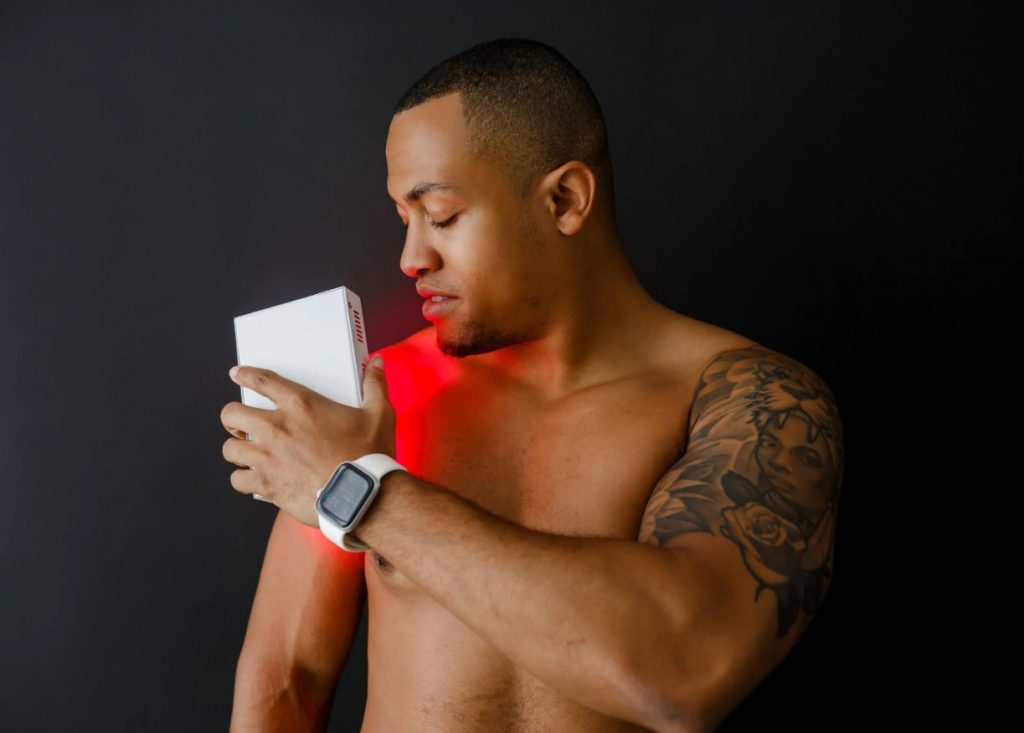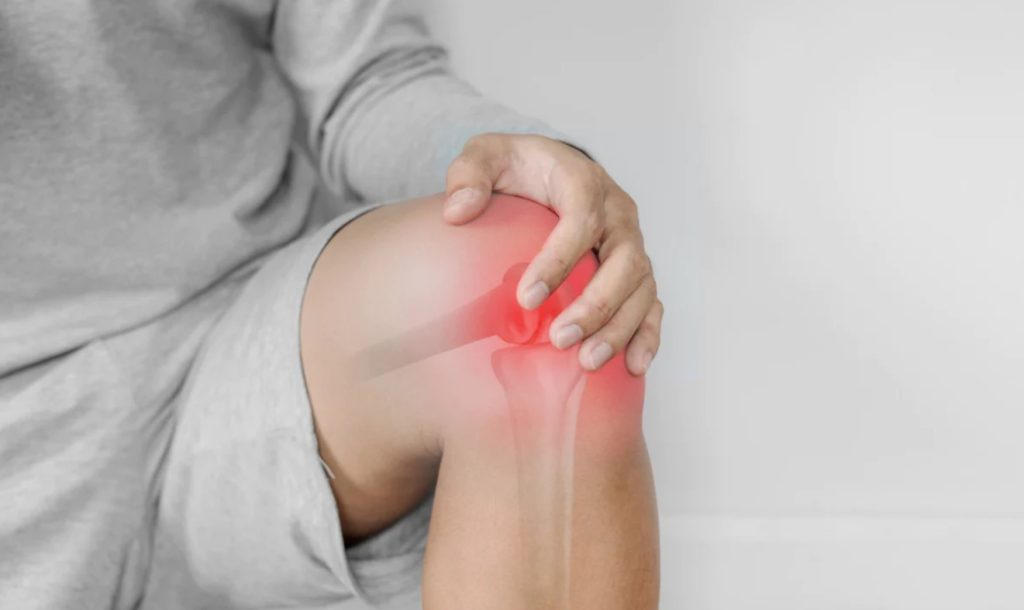Gout, a form of inflammatory arthritis, can cause severe pain and discomfort. The quest for effective treatment has led to the exploration of solutions like red light therapy.
Traditionally, gout management has involved medications, lifestyle changes, and diet adjustments. However, the rise of red light therapy has provided a glimmer of hope for those who find conventional treatments ineffective or burdensome. But does red light therapy help gout pain?
Red light therapy uses low-level red light wavelengths to potentially trigger healing responses in the body. There’s growing interest in the potential of this light therapy to combat inflammatory conditions like gout and joint pain in general.
We’ll examine the scientific backing for red light laser therapy and its potential role in managing gout. Will red light therapy prove to be a beacon of relief for gout sufferers?
Let’s find out.

Source: mitoredlight.com
Does Red Light Therapy Help Gout?
Applying red laser therapy to a joint affected by gout may greatly improve its condition. Red light therapy has been proven to possibly help with joint stiffness and pain. It might also help tendons and soft tissue regenerate much faster after damage.
Circulation increases are also well documented as a result of the effects of red light, which may greatly help with mobility and the healing process by bringing more oxygen to the tissue.
There should be no harmful side effects; you may use it long-term without any problems. The therapy may be entirely safe to use, painless, and doesn’t emit harmful heat. To top it all off, it’s a completely non-invasive process.
Red light devices
Red light therapy devices can be adjusted to fit any joint. They’re small, simple to use, and ideal for home use. These devices are ideal for attaching to any joint on the body and are used hands-free, potentially helping instant relief without any hassle.
Red light therapy is extremely simple to administer. The most popular and mainstream way to do it is at a red-light sauna. These are large rooms covered in red light LEDs that fill the room with light. More and more of these rooms have been popping up at places like gyms and wellness centers.
However, to better concentrate the light on a single joint affected by gout, it’s advisable you invest in a red light device. These devices can be attached directly to the part you want to treat, and all of the light is concentrated there. You can also visit a clinic that provides this service if you want to test it out first or don’t want to buy a device.
There are also new high-powered super lasers that are meant for the treatment of gout. These lasers might provide deep tissue penetration, which is more effective for soothing the symptoms of gout.
Ensuring penetration to the joints
It’s important to ensure that the light can penetrate deep enough to effectively treat gout. Anything below the wavelength of 600 nanometers or over 950 nanometers won’t be able to penetrate directly into the joint area.
The range between 740 and 850 nanometers seems to be the ideal amount for directly hitting the sweet spot of the joint. With wavelengths of around 820 nanometers, RLT has the best effects on the cells. So, when buying a red light therapy device, make sure it operates on that level.
Red Light Therapy and Arthritis
Arthritis is one of the leading causes of disability, which is characterized by intense pain from inflammation in one or more joints of the body. While arthritis has many different forms and is usually associated with older people, it can affect pretty much anyone, regardless of age and gender.
Some sources claim that red light therapy has been used clinically to treat arthritis since the late 80s. Moreover, by the year 2000, enough scientific evidence was gathered to support red light therapy as a way for people with arthritis to alleviate pain and discomfort.
Since then, several thousand quality clinical studies have tried to refine the parameters for treating all joints. Lately, many forms of light therapy are considered to be a reliable way to treat the pain of arthritis.
It may have the potential to be a proactive healthy treatment against root causes of osteoarthritis, rheumatoid arthritis, and gout.

Source: en.drserhanyagdi.com
About Gout
Gout is a type of arthritis that usually affects the big toe joint. It is accompanied by sudden burning pain, stiffness, and swelling at the joint. Gout is usually the result of a high level of uric acid in the body, which later accumulates in various regions of the body as crystalline deposits.
These crystals are a constant source of pain and inflammation until the gout is treated. Leaving gout unattended could seriously harm the surrounding tendons and other soft tissue. And usually, when we imagine gout, we imagine a middle-aged man with sudden toe pain, swelling, and redness. But it can happen to anyone.
The likelihood of gout appearing is increased in overweight people, heavy alcohol drinkers, high meat and fish diet, and a lot of diuretic drinks.
Even though 75% of initial attacks happen in the big toe joint, there is a high chance it can affect any joint in the body. Sometimes both injury and stress can also lead to high levels of uric acid in the bloodstream.
About Red Light Therapy
Red light therapy is a procedure where you use light-emitting diodes, or LEDs, to treat medical and cosmetic conditions. Red light devices send low-intensity red light deep into the body’s cells, which might stimulate healing. The whole process is non-invasive, does not use heat, and is painless.
One of the first modern medical applications for it was by Hungarian physician Endre Mester, who first used red light therapy in 1967 while studying the effects it had on cancer cells.
Today the treatment is used in medical and dental fields, spas, and even at home to help repair tissue and relieve inflammation and pains.
Red light therapy can be referred to by many names, including:
- Low-level laser light therapy (LLLT)
- Cold laser therapy
- Biostimulation
- Photobiomodulation (PBM)
- Low-power laser therapy (LPLT)
- Soft laser therapy
- Photonic stimulation
Red light therapy can also be used as a part of photodynamic therapy. In this case, it’s used to activate an agent, which may help the skin absorb more light.
How does red light therapy work?
Red light therapy uses low levels of red light to activate a part of the cells called the mitochondria, which acts as the cell’s energy generator. Most of that energy is housed in a molecule called adenosine triphosphate, working as storage for the energy.
Illness, unhealthy lifestyle, and aging factor into making the mitochondria produce less ATP, and red light therapy may trigger a reaction that helps reverse this decline.
Red light therapy operates based on the heat that causes activity, which then produces energy. The red light that reaches the cells makes them heat up, start moving and become activated. The infusion of energy in a certain region of tissues might help them heal faster.
Furthermore, red light therapy may help with the following:
- Skin conditions and skin health in general
- Dental pain
- Inflammation
- Anxiety and depression
Does Red Light Therapy Interfere With Other Treatments?
Most people use red light therapy as a single pain management option. However, many people appreciate the fact that it may also be combined with most other treatments without any risk. Red light therapy has not been shown to affect any of the common treatments used for gout treatment.
Multiple treatments used for pain may complement each other, providing a synergistic effect that may more effectively treat the pain. Even though red light therapy may always be used safely without complicating other medical treatments, it’s always a good idea to consult with a medical professional if this type of therapy could interfere with other treatments.
Of course, it’s also important to choose a red light product that is specifically designed to provide wavelengths of light that may promote joint pain relief and goes well with the usual therapies used for gout.
Conclusion
Even though red light therapy is a relatively new treatment, there’s evidence of its possible effectiveness in treating injuries and ailments of the joints.
So, does red light therapy help gout? The answer is not only might red light therapy help gout, but it might also do so immensely well. Red light therapy is used as an active treatment of almost all types of arthritis, and it might be doubly effective when it comes to gout.
If you’re interested in red light therapy as a way to soothe the symptoms of gout, give it a try. Red light therapy is easy to be applied, completely safe, and non-invasive.
By using it, you can begin a chapter in a pain-free life. Consulting a healthcare professional is highly recommended before using this treatment.

Hello! I’m Nicky Rodgers.
Almost a decade ago, I got excited about the idea of employing alternative methods like red light therapy to create a healthier life.
To learn more about it, I did my Certified Light Therapist course from Photonic Therapy Institute and started looking into the intricacies of how light therapy influences several bodily processes. Before I knew it, my interest had become an obsession which resulted in this extensive blog.
Here, I offer countless well-researched articles to help you understand the benefits and uses of light therapy. I hope this information gives you a head start in your wellness journey.
